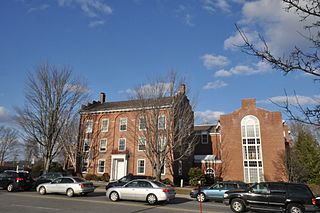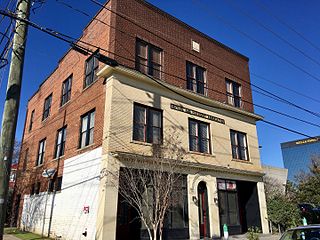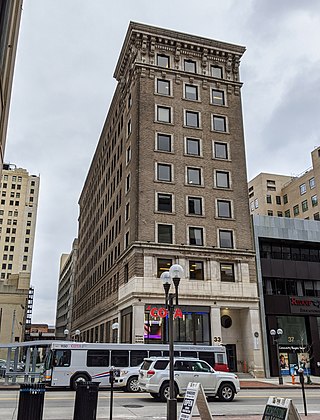
The Sweet Auburn Historic District is a historic African-American neighborhood along and surrounding Auburn Avenue, east of downtown Atlanta, Georgia, United States. The name Sweet Auburn was coined by John Wesley Dobbs, referring to the "richest Negro street in the world," one of the largest concentrations of African-American businesses in the United States.

The Phoenix Mutual Life Insurance Building, locally called the "Boat Building", is a notable Modernist office building located on Constitution Plaza in Hartford, Connecticut. Designed by Max Abramovitz and completed in 1963, it is listed on the National Register of Historic Places and is the world's first two-sided building.

The Farmers' and Exchange Bank is a historic commercial building in Charleston, South Carolina. Built in 1853–54, it is an architecturally distinctive building, with Moorish Revival features rarely seen in the United States. The building is recognizable for its use of muqarnas—characteristic of Persian and North African architecture—as well as its large arched windows and striking red sandstone facade. It was declared a National Historic Landmark in 1973.

The Farmer's and Manufacturer's Bank building is located at the corner of Market and Cannon Streets in downtown Poughkeepsie, New York, United States, near the Bardavon and across from the Dutchess County Court House and Old Poughkeepsie YMCA. It is one of only two non-residential Greek Revival buildings remaining in the city.

The Lincoln American Tower is a 22-story building located at the corner of North Main and Court streets in Memphis, Tennessee. It is also a historical landmark, one of the first steel frame skyscrapers built in Memphis. The tower underwent a six-year refurbishing project starting in 2002, and despite a fire in 2006, is now open and accepting tenants.

The American Bank Note Company Building is a five-story building at 70 Broad Street in the Financial District of Manhattan in New York City. The building was designed by architects Kirby, Petit & Green in the neo-classical style, and contains almost 20,000 square feet (1,900 m2) of space, with offices and residences on the upper floors. The exterior consists of a main facade on Broad Street with two columns, as well as side facades with pilasters on Beaver and Marketfield Streets.

The MBA Building, or Modern Brotherhood of America Building, also known as the Brick and Tile Building, is a large office building in Mason City, Iowa, built in 1916-1917 for the Modern Brotherhood of America, a fraternal lodge. The MBA's primary purpose was to provide life insurance to its members, and the building housed those operations.

Aaron McDuffie Moore, M.D. was a medical doctor, medical director, and officer at a bank, hospital, pharmacy, university and insurer serving African Americans in North Carolina. He was born in Whiteville, North Carolina. He lived in Durham, North Carolina.
NC Mutual was an American life insurance company located in downtown Durham, North Carolina and one of the most influential African-American businesses in United States history. Founded in 1898 by local black social leaders, its business increased from less than a thousand dollars in income in 1899 to a quarter of a million dollars in 1910. The company specialized in "industrial insurance," which was basically burial insurance. The company hired salesmen whose main job was to collect small payments to cover the insured person for the next week. If the person died while insured, the company immediately paid benefits of about 100 dollars. This covered the cost of a suitable funeral, which was a high prestige item in the black community. It began operations in the new tobacco manufacturing city of Durham, North Carolina, and moved north into Virginia and Maryland, then to major northern black urban centers, and then to the rest of the urban South.

The Merrimack County Bank building is a historic commercial building at 214 North Main Street in Concord, New Hampshire. The three-story brick Federal style building was built in 1826 to house the offices of the Merrimack County Bank on the first floor, law offices on the second floor, and a public meeting space above. In 1840, the upper floor was taken over by the New Hampshire Historical Society for use as a library. The Society significantly altered the interior in the early 20th century to convert this space for display purposes. In 1952 the building was acquired by the Christian Mutual Life Insurance Company, which restored the interior to its original Federal appearance, and sold the building to a law firm in the 1970s. The building also housed the law offices of future president Franklin Pierce.

Black Wall Street was the hub of African-American businesses and financial services in Durham, North Carolina, during the late 1800s and early 1900s. It is located on Parrish Street. It was home to Mechanics and Farmers Bank and North Carolina Mutually

North Carolina Mutual Building, also known as the Blue Palace Tea Shop and Barber Shop, is a historic commercial building located at Columbia, South Carolina. It was built in 1909 by the North Carolina Mutual Life Insurance Company, and is a three-story, rectangular, brick commercial block. The building housed African-American businesses, professionals, and institutions during the years of Jim Crow segregation. It is located in the Washington Street business district, the city's black downtown.

Downtown Durham Historic District is a national historic district located at Durham, Durham County, North Carolina. The district encompasses 97 contributing buildings and 1 contributing structure in the central business district of Durham. The buildings primarily date from the first four decades of the 20th century and include notable examples of Colonial Revival, Italianate, and Art Deco architecture. Notable buildings include the St. Philip's Episcopal Church (1907), Durham Arts Council Building (1906), First Presbyterian Church (1916), Trinity United Methodist Church (1880-1881), First Baptist Church (1926-1927), Durham County Courthouse (1916), Carolina Theatre of Durham, (1920s), Tempest Building, National Guard Armory (1934-1937), United States Post Office (1934), Trust Building (1904), First National Bank Building (1913-1915), Mechanics and Farmers Bank (1921), Johnson Motor Company showroom (1927), Hill Building (1935), Snow Building (1933), and S. H. Kress store.

Mutual Tower is a 252k-square foot, 14-story skyscraper located in Durham, North Carolina. Built in 1968, the building was previously called the North Carolina Mutual Life Insurance Company Building, Legacy Tower and The Tower at Mutual Plaza. It was designed by M.A. Ham Associates and Welton Becket and Associates. From 1968 to 1987 this building was Durham's tallest.

Grahame's Corner is a heritage-listed commercial and office building located at 142-144 Pitt Street, in the Sydney central business district, in the City of Sydney local government area of New South Wales, Australia. It was designed by G. A. Morell and built from 1877 to 1882. It is also known as Grahams Corner and the AMFIS Building. The property was added to the New South Wales State Heritage Register on 2 April 1999.

The Mechanics and Farmers Bank is an American bank owned by M&F Bancorp, Inc based in Durham, North Carolina. It served as one of the most influential African-American businesses in North Carolina in the 20th century.

Calvin Esau Lightner was an American architect, building contractor, and mortician. He was born in South Carolina and moved to Raleigh, North Carolina, to study architectural design at Shaw University. After graduation he took industrial courses at Hampton Institute and studied embalming in Tennessee. He and his brother established the C. E. Lightner and Brothers construction company and built numerous homes for members of Raleigh's black middle class.

The William J. Lhota Building is a historic office building on High Street in downtown Columbus, Ohio. The building is primarily known as the headquarters of the Central Ohio Transit Authority (COTA), the city's transit system. It is owned by COTA, with some office space leased to other organizations. The building was added to the National Register of Historic Places as part of the High and Gay Streets Historic District in 2014.

East Hargett Street is a street in downtown Raleigh, North Carolina. It was plotted in 1792 as one of the original streets in the city, and in the early 1900s hosted a concentration of black-owned businesses, thus earning the monikers "Black Main Street"/"Negro Main Street". The street experienced an economic decline in the 1960s.






















